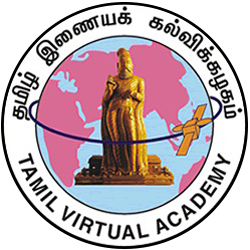Primary tabs
-
LESSON - 1
P10211 - Prose - its Origin and Growth
This lesson traces the origin and growth of prose as an important genre in Tamil literature. The term ‘prose’ or ‘urai nadai’ first finds a mention in the ancient grammatical treatise, ‘Tholkappiam.’
The earliest extant samples of prose are to be found in the epic, ‘Silappadigaram.’ However, the commentaries written by Madurai Kanakkaayanar Maganaar Nakeeranar for the grammatical treatise ‘Irayanaar Kalaviyal’ is considered to be the first prose text in Tamil. This text is noted for the poetic beauty of its lines and the author’s erudition. Initially prose was in the form of commentaries written for literary texts and grammatical treatises. From the 10th century onwards many such commentaries were written. Ilamburanar, Nachinarkiniyar, Peraasiriyar, Senaavaraiyar and Adiyarkkunallar are some of the noted writers of prose commentaries of this period. The period from 10th century A.D. to 15th century A.D. is known as the Age of ‘Uraiyaasiriyargal’ or commentators.
Their lucid style and logical arguments in support of or in refutation of ideas is praiseworthy. Their commentaries played an important role in the growth of Tamil language and literature. They enabled the lay man to understand the nuances of a literary text and appreciate its stylistic merits.
The Uraiyaasiriyargal were largely instrumental in reviving a keen interest in ancient Tamil literature. They also played a major role in preserving and popularizing literary works that were either forgotten or overlooked. Of the commentaries for grammatical treatises those written by Ilamburanaar, Nachinarkiniyar, Peraasiriyar, Senaavaraiyar, Theivachilayar, Kalladar and Sivagnana Munivar for ‘Tholkappiam’ are noteworthy. The lesson includes a brief overview of their commentaries.
This lesson also discusses the commentaries written by various ‘uraiyaasiriyargal’ and the age of several important literary works. Commentaries for texts continued to be written during the Nayakkar period and even after the coming of the Europeans. Nirambavazhagiya Desikar, Mayilerum Perumal, Vaidyanatha Desikar, Saminatha Desikar, Subramanya Desikar and Sivaprkaasar are some of the noted ‘uraiyaasiriyargal’ of the Nayakkar period. Their commentaries were also written in the ancient literary style.
It was only after the advent of the Europeans that Tamil prose acquired a new style much closer to the language of everyday speech. The first Tamil prose text to be printed was ‘Kristobadesam.’ Veeramamunivar was a noted exponent of Tamil prose during the 18th century. His ‘Paramartha Guru Kathaigal’ is striking for its refreshingly new style.
With the advent of printing, a number of books were published in the 19th century. Prose texts on a wide array of subjects were published. Tamil prose flourished during this period. There were a variety of reasons for this. The setting up of printing presses all over the country was the principal reason. In their zeal to spread their religion, the Christian missionaries published a number of religious texts. To counter the onslaught of Christianity, the Hindus brought out books based on their puranas and legends.
Many educational texts were also published during this period. Thandavaraya Mudaliar, Arumuga Navalar, Ramalinga Adigal, Veerasamy Chettiar and P.R.Rajamaiyyar are some of the important prose writers of this period.
In the 20th century, the growth of science and technology and the evolution of new genres such as novel, essay and drama led to a lot of experimentation in prose style. Writers like Bharathiyar, U.Ve. Swaminatha Aiyar, Vedanayagam Pillai, Thiru Vi Ka, and Aringar Anna offered a new lease of life to Tamil prose. Newspapers and Journals such as ‘Desabaktan’, ‘Navasakthi’, ‘Sudesamitran’ and ‘Manikodi’ contributed a great deal to the growth of Tamil prose.



